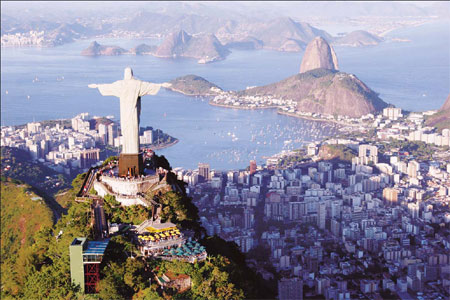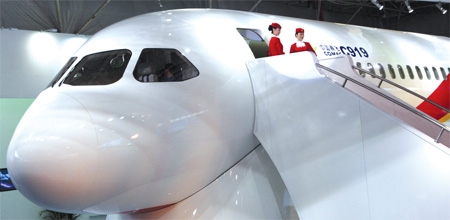Quick trip to Rio full of fun
Updated: 2010-08-29 11:15
By Wang Ru (China Daily)
 |
|
Arms outstretched in the act of blessing, the statue of |

The barbecue or churrasco is representative of Brazilian cuisine.

Brazilian obsessions: Football and Copacabana Beach. wang ru / China Daily
Rio de Janeiro is Brazil's second largest city, and one of the most popular tourist destinations in South America. Wang Ru spends a day and a half exploring the city that will host the 2014 World Cup and the 2016 Olympic Games.
Brazilians say God created the world in six days, and on the seventh day, he created Rio de Janeiro. After flying 30 hours from Beijing to Brazil with stopovers in Doha and Sao Paolo, I was ready to find out if this was true. I woke up to the sound of the local television news in Portuguese at the Best Western Rio Copa (Av Princesa Isabel 370, Copacabana BR Rio De Janeiro, 22011-010), a hotel just 10 minutes away from the famous Copacabana beach.
I couldn't wait to explore the city. It was winter in Brazil but the temperature was a mild 25 degrees Celsius with pleasant sunlight and a light sea breeze. Despite the long hours traveling here, Rio de Janeiro seemed the perfect place to escape the sauna summer of Beijing.
Although it is not Carnival season, traveling to Rio de Janeiro in July and August can be relaxing. The beaches are not crowded and hotels usually offer good discounts.
The city is hosting the Olympic Games in 2016, and I expected to see plenty of construction everywhere, just like Beijing in the build up to the 2008 games. But no, Rio is keeping its own laid-back pace.
Like most tourists, we first headed out to Rio's most famous symbol - the statue of Christ the Redeemer atop Corcovado Mountain.
Thirty minutes from the hotel, we boarded one of the red carriages of the Corcovado Train (Trem do Corcovado), a railway built in 1884 traveling to the peak.
Famous previous passengers of Brazil's first electric railway include two Popes, Albert Einstein, Diana, Princess of Wales, and the 700-ton statue of Christ itself in the late 1920s.
The train climbs almost four kilometers across the largest urban forest in the world - the national park of Tijuca, an 8000-acre rainforest that is one of the last remnants of the Atlantic Rainforest that once dominated the southern coast of Brazil.
The 20-minute rail journey passes through tropical flora, singing birds and stunning waterfalls. You can also choose to walk up, if you like a closer encounter with nature.
The railway runs from 8:30 am to 6:30 pm daily. The journey takes only 20 minutes, but the wait for the train may take considerably more time.
An elevator brings visitors to the top platform where the statue stands and once there, it is easy to understand why it was chosen as one of the new Seven Wonders of the World, along with the Great Wall of China, by the Swiss-based New7Wonders foundation.
The almost 40-meter-tall statue is the joy and pride of Rio. It was built in 1922 and opened to the public in 1931. Inside the 9.5-meter-tall pedestal is a chapel where Catholics regularly hold baptisms and weddings.
Recently, graffiti defaced the statue's head and right arm and an angry mayor condemned the act as "a crime against the nation" and vowed to jail the vandals, offering a huge reward for any information that may lead to an arrest.
The statue of Christ the Redeemer is indeed awe-inspiring, with its arms seeming to embrace all that is below, including the city, forests, mountains, ocean and beaches.

It is prudent to weather-watch before a trip up. A cloudy day will ruin the view and the wonderful sunsets seen from the vantage point.
If the statue of Christ represents Rio de Janeiro, then Brazilian barbecue or churrasco is synonymous with its food. It is found in all major cities worldwide, including Beijing where it is especially popular.
A veteran gourmet may sniff at my recommendation of Brazilian churrasco, but there is nothing more energizing after a passionate Carnival parade, a samba dance or a soccer match.
To sample an authentic version, a good place to go is Estrela Do Sul. There is an outlet near Maracana Stadium, (Avenida Maracana, 649-Tijuca-RJ. Tel: (21) 2254-0630, maracana@estreladosul.com.br).
Brazilians are fervent about their grilled meats, but they are equally passionate about their soccer. Our tour guide Christina could not say why Brazilians play such brilliant soccer but she took us to see the huge Maracana Stadium.
It is named after a red-caped macaw, a native bird, but to Brazilians, Maracana is the name of the mecca of soccer. It was built in 1948 in preparation for the 1950 World Cup and was the world's largest stadium at the time.
It can seat more than one hundred thousand people and once, when Brazil played Uruguay in the final, officials recorded 170,000 spectators. Some say the figure was nearer 220,000, or about 10 percent of Rio's total population then.
By 2014, Maracana Stadium will be upgraded for the World Cup and it will also host the opening ceremony of 2016 Olympic Games.
My only regret was that I missed the famous Carnival, which takes place every year 40 days before Easter.
This is when musicians, floats, parades and samba dancers populate the streets and an incredibly joyful and festive atmosphere blankets the whole city.
The next best thing was visiting one of the samba schools. There are about 70 of them in different communities, most originally a part of local soccer clubs.
"A samba school is not a college to teach you how to dance the samba. Rather, it is a club where you can attend samba nights and learn by watching the dancing," our guide told us.
During the four-day carnival, the samba schools will compete against each other with the best music, lyrics, costumes and dancing .
We were told not to go out after dark because security is an issue in Rio de Janeiro. Visitors are warned not to carry their passports, to avoid using ATMs on the streets and in general, avoid looking like rich, lost tourists at night.
But my friend and I agreed we did not fly 30 hours halfway across the globe to stay inside a hotel room after dark - so we decided to brave the "hazardous night" and head for Copacabana.
The silver sands of this famous beach stretch across four kilometers. On sunny days, Brazilians turn up with deck chairs, umbrellas, bottles of suntan lotion and cool drinks from the beach bars.
At night, the beach becomes football paradise.
We joined some local kids playing ball and were soon put to shame by the dazzling moves of a 5-year old.
But, it was a good way to say goodbye to fascinating Rio de Janeiro.
Paper's Digest

Chinese jet takes on Big 2
First large commercial plane set to ride on demand for aircraft as economy grows.
Super-CPU only for domestic eyes
Specials

Chinese jet takes on Big 2
First large commercial plane set to ride on demand for aircraft as economy grows.

Gaining ground
Doing business in china for westerners has come a long way, Peter batey says.

Safeguarding environment a priority
China continues to face mounting pressure to curb environmental degradation, despite progress in reducing pollution over the last five years, the environmental protection minister warned.
